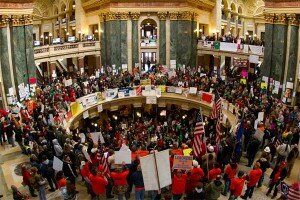
Unionization in the United States has always been an uphill battle. In early America, when workers attempted to unionize there was deadly opposition from the merchant class supported in many ways by elected politicians. The intense and sometimes successful struggle to have unions grew out of numerous violations of workers rights; long hours, low wages, poor and hazardous working conditions, and child labor. These and other abuses pushed workers to demand rights, protection, and safety and to be paid a living wage.
From the east coast to the west coast men and women agitated, protested and demonstrated for these rights. They understood the power in numbers and unity and therefore pushed for union representation demanding the right to organize and bargain collectively. There were some courageous individuals who risked beatings, jail and even death in their campaign to organize workers. People like Eugene Debs, Mother Jones, Bill Hayward. Then these individuals were fighting corrupted politicians and the “Robber Barons”, some of the most influential and wealthy industrialists of the 19th and early 20th centuries. These industrialists gained much of their wealth through the exploitation of their workers.
Beginning in the early 1900’s the United States saw an increase in unions and union membership in both public and private sectors. However, according to the Bureau of Labor Statistics, private sector unionization peaked in 1958 at 30% and has continued to fall to where it is today which is below 12%. The story is different for the public sector where there has been small but steady increases in union membership until 2010 when union membership dropped from 37.4% to 36.2%.
The Bureau of Labor Statistics explains the drop in part by, the economic crisis resulting in lay-offs and plant closings, particularly in areas with strong union membership like, manufacturing, construction, education and government.
Barry T. Hirsch, a labor economist at Georgia State University, said that companies have grown more ideologically opposed to unions and are more aggressive about resisting organizing drives. This resistance is based in part on the fact that workers in unionized companies have better benefits and higher wages, which of course will decrease profits. Jack Welch, former CEO of General Electric back in the 1990s said “Why am I paying $25.00 an hour for an American worker, when I can hire a well educated, Indian worker in India, that speaks perfect English, for only $3.00 an hour!” He went on to say, “if I could, I would build all of my factories on barges. That way, I could move them to wherever there was the cheapest available labor.”
I believe that one reason the middle class in America grew was due in large part to the growth of unions and the accompanying increases in wage and benefits resulting in worker security and safety.
The current attacks on unions are related to the two “Ps” profits and politics. The two work in concert. Historically, unions have been strong supporters of the Democratic Party. They have been major financial contributors to Democratic candidates and during elections are renowned for being able to put troops on the ground to get out the vote. This union power is something the Republican Party wants to destroy and after the mid-term elections of 2010 it became a goal and the state of Wisconsin became the launching pad. The move did not go as planned and has set off a firestorm of resistance and angry. The eventual outcome is uncertain, but battle line has been drawn. Unions and workers are united in fighting to protect their rights and are striking back at the people geared toward their destruction.